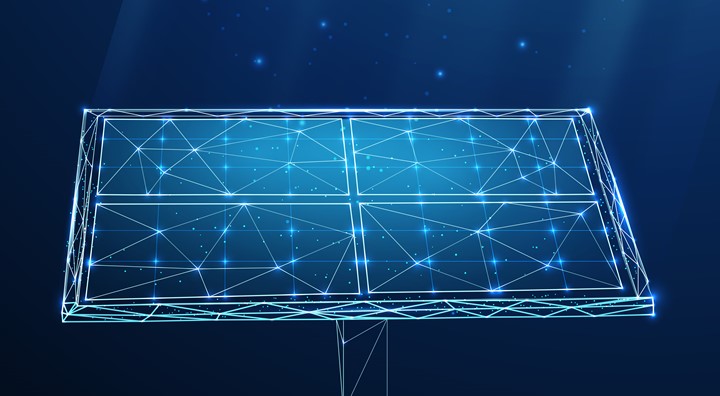Research
Research focuses on fundamental photo-physical processes at the molecular and meso-scale and how they determine device performance and their physical limits. In addition, the group aims at translating these insights into novel device concepts for future electronic applications in energy and healthcare.


View the content of this page
Research lines

Polymer-Based Electronics
Devices based on semiconducting polymers benefit from a large variety of chemical structures and can be deposited using low-cost, solution-based deposition techniques. In a proof of concept study, we have developed a low-cost, miniature spectro-photometer which is for example able to remotely detect water, based on its near-infrared transmission. Besides printed, polymer based photodetectors, we also develop and optimize polymer-based solar cells, light emitting diodes and transistors. The picture refers to our study by Tang et al. published in Advanced Materials (DOI: 10.1002/adma.201702184).

Small-Molecule Based Electronics
Devices based on vacuum-processed small molecules benefit from a solid reproducibility as well as an effortless lateral structuring and vertical stacking. An example are the organic light emitting diodes (OLEDs) used today in phone displays and TVs. We have recently demonstrated a new device architecture for low-cost optical sensors based on vacuum deposited small molecules which is currently in commercialisation . Besides photodetectors, we also develop and optimize small molecule-based solar cells and light emitting diodes. The picture refers to our study from Siegmund et al. published in Nature Communications (DOI: 10.1038/ncomms15421).

Nano-Optics
Dielectric mirrors or distributed Bragg reflectors are high-quality mirrors with superior reflectivities up to 99.9%. They are ideal to combine with strongly emitting or absorbing organic materials to create microcavities. These allow for fundamental research on strong light-matter coupling, Bose-Einstein condensation and other quantum effects. Beyond that, applications of dielectric mirrors range from hot mirrors, to narrowband sensors and lasers. We fabricate the mirrors via e-beam deposition which is highly compatible with the deposition of organic semiconductors.

Ultra-Sensitive Steady-State and Time-Resolved Spectroscopy
We study optical absorption and emission processes in thin film using a series of ultra-sensitive techniques such as photothermal deflection spectroscopy, photoluminescence excitation spectroscopy and Fourier-transform photocurrent spectroscopy. We have a wavelength tunable CW laser as well as nano-second pulsed lasers available as excitation source and use the most sensitive state-of-the-art and home-made spectroscopic setups and cameras available. In this way, we are able to achieve a deep understanding on the mechanisms of photocurrent generation, charge transport and radiative and non-radiative decay in organic and other emerging semiconductors, as for example done in our study by Liu et al. published in Joule (DOI: 10.1016/j.joule.2021.06.010).

Molecular and Device Scale Simulations
Complementary to our experimental work, we apply computational techniques to model processes on the molecular scale, such as the absorption and luminescence of molecules, aggregates and blends. This is combined with optical simulations and electrical drift-diffusion simulations on the device scale to understand and optimize charge injection/extraction, transport and recombination processes in organic opto-electronic devices consisting of multiple functional layers with a typical total thickness of about 100 nm. The simulation shown above represents the optical field distribution in an organic solar cell being optimized to trap a maximum of light in the active layer. The subsequent carrier distribution, given by the balance between dynamic processes of generated carriers is critical to determine the device performance. Similar types of simulations are also used to design and optimize organic light emitting diodes for which the spectrum and outcoupling efficiency of the emitted light is affected by thin film interference effects and the position of the recombination zone.
Selected Publications
2018 - Today
2018 - Today
Sigurd Mertens, Bernhard Siegmund, Koen Vandewal
Materials Horizons, 2022
Quan Liu, Sander Smeets, Sigurd Mertens, Yuxin Xia, Andrea Valencia, Jan D’Haen, Wouter Maes, Koen Vandewal
Joule, 2021
Jochen Vanderspikken, Wouter Maes, Koen Vandewal
Advanced Functional Materials, 2021
Sam Gielen, Christina Kaiser, Frederik Verstraeten, Jonas Kublitski, Johannes Benduhn, Donato Spoltore, Pieter Verstappen, Wouter Maes, Paul Meredith, Ardalan Armin, Koen Vandewal
Advanced Materials, 2020
Yifan Dong, Vasileios C Nikolis, Felix Talnack, Yi-Chun Chin, Johannes Benduhn, Giacomo Londi, Jonas Kublitski, Xijia Zheng, Stefan CB Mannsfeld, Donato Spoltore, Luca Muccioli, Jing Li, Xavier Blase, David Beljonne, Ji-Seon Kim, Artem A Bakulin, Gabriele D’avino, James R Durrant, Koen Vandewal
Nature Communications, 2020
Sascha Ullbrich, Johannes Benduhn, Xiangkun Jia, Vasileios C Nikolis, Kristofer Tvingstedt, Fortunato Piersimoni, Steffen Roland, Yuan Liu, Jinhan Wu, Axel Fischer, Dieter Neher, Sebastian Reineke, Donato Spoltore, Koen Vandewal
Nature Materials, 2019
Vasileios C Nikolis, Andreas Mischok, Bernhard Siegmund, Jonas Kublitski, Xiangkun Jia, Johannes Benduhn, Ulrich Hörmann, Dieter Neher, Malte Christian Gather, Donato Spoltore, Koen Vandewal
Nature Communications, 2019
Contributions before OOE
Contributions before OOE
Johannes Benduhn, Kristofer Tvingstedt, Fortunato Piersimoni, Sascha Ullbrich, Yeli Fan, Manuel Tropiano, Kathryn A McGarry, Olaf Zeika, Moritz K Riede, Christopher J Douglas, Stephen Barlow, Seth R Marder, Dieter Neher, Donato Spoltore, Koen Vandewal
Nature Energy, 2017
Zheng Tang, Zaifei Ma, Antonio Sánchez‐Díaz, Sascha Ullbrich, Yuan Liu, Bernhard Siegmund, Andreas Mischok, Karl Leo, Mariano Campoy‐Quiles, Weiwei Li, Koen Vandewal
Advanced Materials, 2017
Bernhard Siegmund, Andreas Mischok, Johannes Benduhn, Olaf Zeika, Sascha Ullbrich, Frederik Nehm, Matthias Böhm, Donato Spoltore, Hartmut Fröb, Christian Körner, Karl Leo, Koen Vandewal
Nature Communications, 2017
Contact
Prof. dr. ir. Koen Vandewal

Wetenschapspark 1, 3590 Diepenbeek, Belgium
Materials physics & engineering

Wetenschapspark 1, 3590 Diepenbeek, Belgium













